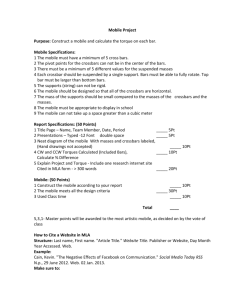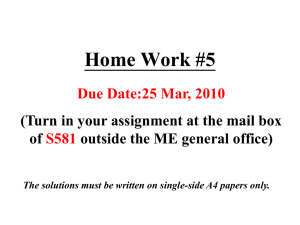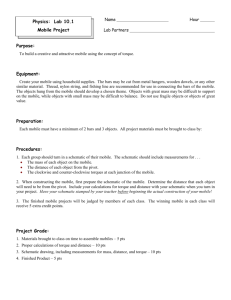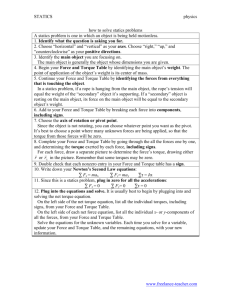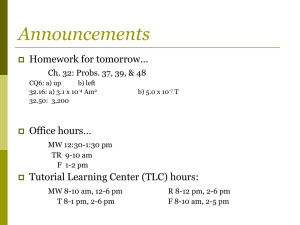Mobile Project Keith Paxton, Bentonville High School
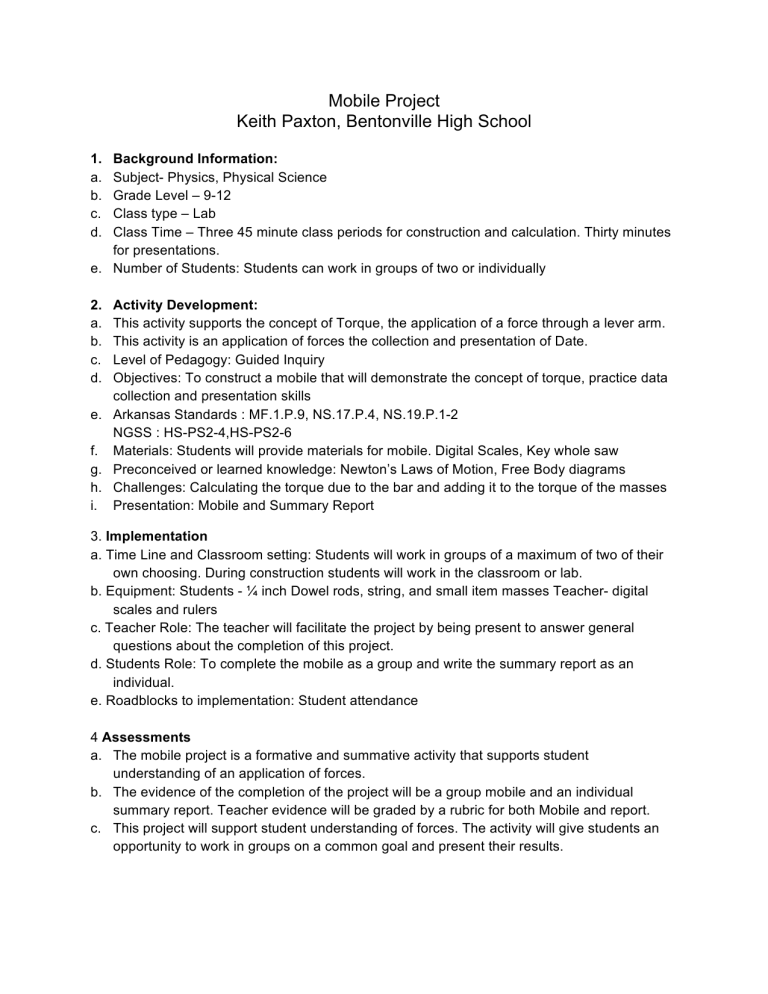
Mobile Project
Keith Paxton, Bentonville High School
1. Background Information: a. Subject- Physics, Physical Science b. Grade Level – 9-12 c. Class type – Lab d. Class Time – Three 45 minute class periods for construction and calculation. Thirty minutes for presentations. e. Number of Students: Students can work in groups of two or individually
2. Activity Development: a. This activity supports the concept of Torque, the application of a force through a lever arm. b. This activity is an application of forces the collection and presentation of Date. c. Level of Pedagogy: Guided Inquiry d. Objectives: To construct a mobile that will demonstrate the concept of torque, practice data collection and presentation skills e. Arkansas Standards : MF.1.P.9, NS.17.P.4, NS.19.P.1-2
NGSS : HS-PS2-4,HS-PS2-6 f. Materials: Students will provide materials for mobile. Digital Scales, Key whole saw g. Preconceived or learned knowledge: Newton’s Laws of Motion, Free Body diagrams h. Challenges: Calculating the torque due to the bar and adding it to the torque of the masses i. Presentation: Mobile and Summary Report
3. Implementation a. Time Line and Classroom setting: Students will work in groups of a maximum of two of their own choosing. During construction students will work in the classroom or lab. b. Equipment: Students - ¼ inch Dowel rods, string, and small item masses Teacher- digital scales and rulers c. Teacher Role: The teacher will facilitate the project by being present to answer general questions about the completion of this project. d. Students Role: To complete the mobile as a group and write the summary report as an individual. e. Roadblocks to implementation: Student attendance
4 Assessments a. The mobile project is a formative and summative activity that supports student understanding of an application of forces. b. The evidence of the completion of the project will be a group mobile and an individual summary report. Teacher evidence will be graded by a rubric for both Mobile and report. c. This project will support student understanding of forces. The activity will give students an opportunity to work in groups on a common goal and present their results.
5 Reflections a. Your initial role will be teacher but it should shift to facilitator. b. Students will have difficulties calculating the torque of the bar adding it to the torque of the masses. c. Students enjoy using their artistic talents and connecting it to physics.
Mobile Project
Purpose: Construct a mobile and calculate the torque on each bar.
Mobile Specifications:
1 The mobile must have a minimum of 5 cross bars.
2 The pivot points for the crossbars can not be in the center of the bars.
3 There must be a minimum of 5 different values for the suspended masses
4 Each crossbar should be suspended by a single support. Bars must be able to fully rotate.
Top bar must be larger than bottom bars.
5 The supports (string) can not be rigid.
6 The mobile should be designed so that all of the crossbars are horizontal.
7 The mass of the supports should be small compared to the masses of the crossbars and the masses.
8 The mobile must be appropriate to display in school
9 The mobile can not take up a space greater than a cubic meter
Report Specifications: (50 Points)
1 Title Page – Name, Team Member, Date, Period
2 Presentations – Typed -12 Font double space
3 Neat diagram of the mobile
With masses and crossbars labeled, (Hand drawings not accepted)
4 CW and CCW Torques Calculated (Included Bars),
Calculate % Difference
5 Explain Project and Torque - Include one research internet site
Cited in MLA form - > 300 words
Mobile: (50 Points)
1 Construct the mobile according to your report
2 The mobile meets all the design criteria
3 Used Class time
_____ 5Pt
_____ 5Pt
_____ 10Pt
_____ 10Pt
_____ 20Pt
_____ 10Pt
_____ 30Pt
_____ 10Pt
Total ____
5,3,1- Master points will be awarded to the most artistic mobile, as decided on by the vote of class
Teacher Guide
• Tell students to keep their mobiles simple
• Use ¼ inch dowel rods and small objects
• Calculate the mass of the bar by using a % of the total bars mass and the distance from the fulcrum to the center of that % of mass.
Example Student Work
E
.041m
.149m
.083m
.027m
Amanda Wadley
Period 5
D
.032m
.131m
.024m
.080m
.163m
.033m
Bars .0038kg
.03724N
C
.100m
.037m
.018m
.102m
.130m
.050m
B
.0057kg
.05586N
.012kg
.1176N
.030kg
.294N
.0118kg
.11564N
.031m
.099m
.0016kg
.01568N
.141m
.029m
A
.003kg
.0294N
Mobile Project
Clockwise (CW) Torques
Bar 1
Force (=mg)
Distance
Torque
Bar 2
Mass 1
0.2145
0.17
0.0365
Force (=mg)
Distance
Torque
Bar 3
Mass 1
0.21021
0.2
0.04204
Force (=mg)
Distance
Torque
Bar 4
CW Bar
0.002105
CW Bar
SUM OF CW TORQUES
0.02476 xxxxxxxxxxxxxxxxxxxxxxxxxx
0.085 xxxxxxxxxxxxxxxxxxxxxxxxxx
SUM OF CW TORQUES
0.03861
0.0254 xxxxxxxxxxxxxxxxxxxxxxxxxx
0.1 xxxxxxxxxxxxxxxxxxxxxxxxxx
0.00254
0.04458
Mass 1
0.2843
0.195
0.0554
CW Bar SUM OF CW TORQUES
0.0219 xxxxxxxxxxxxxxxxxxxxxxxxxx
0.0975 xxxxxxxxxxxxxxxxxxxxxxxxxx
0.00214
0.05754
Force (=mg)
Distance
Torque
Bar 5
Mass 1
0.3609
0.195
0.07038
CW Bar SUM OF CW TORQUES
0.02529 xxxxxxxxxxxxxxxxxxxxxxxxxx
0.0975 xxxxxxxxxxxxxxxxxxxxxxxxxx
0.002466
0.07285
Force (=mg)
Distance
Torque
Mass 1
0.8618
0.11
0.0948
CW Bar SUM OF CW TORQUES
0.01427 xxxxxxxxxxxxxxxxxxxxxxxxxx
0.055 xxxxxxxxxxxxxxxxxxxxxxxxxx
0.000785
0.09558
Counterclockwise (CCW) Torques
Mass 2
Mass 2
Mass 2
0.5438
0.105
0.0571
CCW Bar
0.0118
0.0525
0.000619
Mass 2
0.686932
0.105
0.07144
CCW Bar
0.01362
0.0525
0.000715
Mass 2
0.2956
0.13
0.0384
0.4386
0.1
0.0439
0.5193
0.18
0.0935
CCW Bar
0.01894
0.065
0.00123
CCW Bar
0.000635
CCW Bar
0.0127
0.05
0.02334
0.09
0.0021
